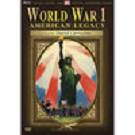|
|
||||
|
by Betty Jo Tucker  I’ve admired Mark Bussler’s work as a documentary filmmaker for a long time now, mostly because of his exceptional ability to create visually appealing movies that both enlighten and entertain us. Happily, Bussler consented to an e-mail interview concerning his splendid new documentary, World War 1 – American Legacy. His in-depth answers to my questions are presented below. QUESTION: Why did you choose WW 1 as a subject? BUSSLER: I have produced and directed a number of Civil War documentaries over the past several years and as a result have become very interested in the lives of the soldiers who fought as individuals. It seemed a natural progression to focus on Americans from a different time and a different war and that brought me to World War 1. I had previously worked with writer, Brian Connelly, on Expo – Magic of the White City and enjoyed his colorful writing style and thought it would work well illustrating a darker subject. Over the past two years he collected a number of great stories from period sources and the goal was to bring these veterans from 1914 through 1918 back to the consciousness of modern day Americans. On the surface they are amazing stories but their actions made a direct, lasting impact on our country today, and we owe it to them and to ourselves to remember why. QUESTION: What did you find most challenging about making this documentary? BUSSLER: As in any documentary, I always find the final technical details to be the most challenging. Once the script and rough cutting is all complete I get very picky when it comes down to audio and video quality and more specifically, the directing and editing. I literally wear my eyes out when editing these films because I want everything to be perfect. Every picture is sharp, every cut has the proper timing and every music cue and sound effect has a reason to be there. A documentary film budget can be less than the size of the food and catering budget on a feature film and we’re all competing in the same market; viewers expect the best and I strive for perfection. QUESTION: How does this documentary compare with you others in terms of the amount of work required? BUSSLER: This was a tough film to make because it is primarily illustrated with period photographs and images, like Expo – Magic of the White City was. However, in Expo if I wanted a shot of the QUESTION: How did you find the great period music you included? BUSSLER: As George Lucas said “the sound and music are 50% of the entertainment in a movie." ...and most of what I know in life is from Star Wars so it made sense to throw everything but the kitchen sink into the soundtrack for this film which is why I included both DTS and Dolby Digital soundtracks to hear it all. I am familiar with period WW1 era songs because my grandfather has a fully functional Several Edison cylinders from his collection are used in the film including a great song about sending American troops cigarettes and also one about how getting married prepares a man for fighting in war. In the documentary there’s a nice story about James Reese Europe and the Harlem Hell Fighters where his music is used to score that section. I also pulled some old favorites like “Over There,” and the “March of the 69th QUESTION: Are there things about WW 1 you wish you had included? If so, please explain why. BUSSLER: This film only scratches the surface of the enormity and complexity of The Great War. It gives a nice overview to help everyone understand how it started, how the I did make a last minute change. I’m an animal lover and dog owner and was so inspired by the actions of the horses, dogs and pigeons that I asked Brian to write a section on them. That turned out to be one of my favorite sections in the film. Cher Ami [the carrier pigeon] rocks. QUESTION: Is David Carradine as serious in real life as he sounds while narrating your film? BUSSLER: All of the famous actors I have worked with over the past several years are very serious about their profession and add their own personal touch to the reading of the script which is why they are so engaging to listen to. I wanted to work with him specifically because of his unique style which I feel is very fitting for a film on World War 1. He gives a very powerful performance. QUESTION: What is David like to work with? BUSSLER: Recording went well and the narration on the documentary is stunning in my opinion. His reading of the poem “Rendezvous” by Alan Seeger is poignant after learning about the horrors that people went through in the war. QUESTION: What upcoming projects are you considering? BUSSLER: I’m in pre-production on several documentaries now and also considering others. After learning so much about WW1 and wanting to get back into writing, I am creating a documentary screenplay based on the poems and writings of WW1 veterans. In American Legacy we use poems from famous writers like Seeger and Joyce Kilmer, however many of what I consider to be the most personal poems were written by unknowns. They give a very detailed view of the war, why they were fighting it and what they really felt. I even have stories written by soldiers about their dogs in the war which are really touching. I am also in pre-production on our 5th Civil War Minutes documentary tentatively called Winters of War about the veterans of the Civil War who built and shaped modern We’re also working on another documentary about the World’s Fair of 1893 and uncovering many of the details and stories that we were unable to fit into Expo - Magic of the QUESTION: What’s the most important thing you want people to know about World War 1 – American Legacy? BUSSLER: World War 1 created the situations that would eventually lead to World War 2 and the conflicts that we are facing today in the The Great War seems more distant and less clear. It is not covered in classes like the Civil War or WW2 and its veterans have been overshadowed. For instance, November 11th is no longer called Armistice Day, it is now Veterans' Day. If viewers can take away one thing from this film it is the desire to learn more about those who served in The Great War. There is a line in the film that says “…statues and monuments all over our country record the hundreds of thousands of anonymous neighborhood boys and girls who went off to fight in America’s first World War. The next time you see one, give it a closer look.” That pretty much sums it up. QUESTION: Is there any other information you would like to share with our ReelTalk visitors? BUSSLER: First of all I would like to thank you and everyone at ReelTalk Movie Reviews for supporting my work and Inecom Entertainment Company from the beginning. We are an independent studio and distribution company working with producers to create quality documentary films. I think that any truly independent filmmaker knows that completing anything and getting it to market is an uphill battle. Rather than solely reviewing 200-million-dollar-special-effects thrillers, you’ve reviewed quality films from all genres and helped to raise awareness of real independent work. Other films that we are releasing are Blood and Oil – World War I in the Middle East by Marty Callaghan and a film on glider pilots in World War 2 called Silent Wings by Robert Child. I’d also like to mention that this film is 100% made in (World War 1 – American Legacy, a DVD release by Inecom Entertainment, will be available beginning Click here to read Betty Jo’s review of World War 1 -- American Legacy.
|
||
|
© 2024 - ReelTalk Movie Reviews Website designed by Dot Pitch Studios, LLC |




